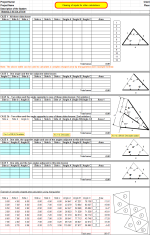Resolutions of Triangles

Description
In trigonometry, a triangle is a geometric shape consisting of three sides and three angles. The sides of a triangle are typically labeled as a, b, and c, and the angles opposite those sides are labeled as A, B, and C, respectively.
The process of solving a triangle involves finding the unknown sides and angles based on the given information. There are several methods to solve a triangle, including:
- Law of Sines: This law relates the ratios of the length of a side of a triangle to the sine of the opposite angle. It can be written as:
a/sin A = b/sin B = c/sin C
Using this law, we can solve for any of the unknown sides or angles of a triangle.
- Law of Cosines: This law relates the lengths of the sides of a triangle to the cosine of one of the angles. It can be written as:
a^2 = b^2 + c^2 - 2bc cos A
b^2 = a^2 + c^2 - 2ac cos B
c^2 = a^2 + b^2 - 2ab cos C
Using this law, we can solve for any of the unknown sides or angles of a triangle.
-
Right Triangle Trigonometry: In a right triangle, one angle is 90 degrees, and the other two angles are complementary. We can use trigonometric functions such as sine, cosine, and tangent to solve for the unknown sides and angles.
-
Pythagorean Theorem: This theorem states that in a right triangle, the sum of the squares of the lengths of the legs (the two sides that form the right angle) is equal to the square of the length of the hypotenuse (the side opposite the right angle). It can be written as:
a^2 + b^2 = c^2
Using this theorem, we can solve for any of the unknown sides of a right triangle.
By combining these methods, we can solve any triangle, whether it is acute, obtuse, or right-angled. The process involves using the given information and applying the appropriate trigonometric laws and identities to find the unknown sides and angles.
Calculation Preview
Full download access to any calculation is available to users with a paid or awarded subscription (XLC Pro).
Subscriptions are free to contributors to the site, alternatively they can be purchased.
Click here for information on subscriptions.

